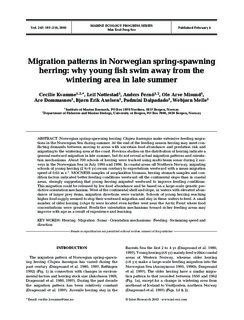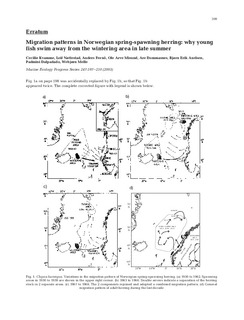| dc.description.abstract | Norwegian spring-spawning herring Clupea harengus make extensive feeding migrations in the Norwegian Sea during summer. At the end of the feeding season herring may meet conflicting demands between moving to areas with uncertain food abundance and predation risk and migrating to the wintering area at the coast. Previous studies on the distribution of herring indicate a general eastward migration in late summer, but do not reveal actual migration patterns and orientation mechanisms. About 700 schools of herring were tracked using multi-beam sonar during 2 surveys in the Norwegian Sea in July 1995 and 1996. In coastal areas off Northern Norway, migrating schools of young herring (2 to 6 yr) swam contrary to expectations westward with a mean migration speed of 0.65 m s(-1). MOCNESS samples of zooplankton biomass, herring stomach samples and condition factors indicated better feeding conditions westward off the continental slope than in coastal areas, strongly suggesting that young herring migrated westward to improve feeding conditions. This migration could be released by low food abundance and be based on a large-scale genetic predictive orientation mechanism. West of the continental shelf and slope, in waters with elevated abundance of larger prey items, migration directions were variable. Schools of young herring reaching higher food supply seemed to stop their westward migration and stay in these waters to feed. A small number of older herring (>Age 6) were located even farther west near the Arctic Front where food concentrations were greatest. Predictive orientation mechanisms toward richer feeding areas may improve with age as a result of experience and learning. | en |

